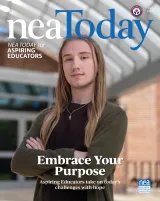A few years ago, at Hamilton Southeastern High School, in Indiana, a class of multilingual students were told to brainstorm in English only for their government class. Many of them were still developing English language skills and struggled to complete the project.

The English learner's department chair, Rebecca Schroeder, stepped in. She encouraged the teacher to allow students to use their first language as part of the process. The results surprised her colleague.
“At first, she was telling them English only,” Schroeder explains. “I said, ‘Let them brainstorm in their first language.’”
The educator soon came back to Schroeder, excited to show her what the students had developed.
“Of course, these are smart, amazing humans. Let them be them,” Schroeder says.
The same scenario is playing out in classrooms around the country, as educators debate how best to teach students who speak multiple languages.
A growing population
Walk into nearly any public school in the U.S., and you’ll likely hear more than one language in the hallways. From Arabic and Amharic to Spanish and Swahili, more than 350 languages are spoken in homes across the country.
Multilingual learners now make up about 10 percent of the nation's public school population and are the fastest growing group of students, according to the National Center for Education Statistics. Yet many teachers report not being prepared to support them.
In a Rand survey of about 7,500 teachers and 1,300 principals across the nation, half of teachers said they were not at all, or only somewhat, prepared to teach multilingual learners. Two-thirds said their materials were inadequate.
Schroeder says her approach is to design lessons based on who is sitting in her classroom.
“I figure out who they are and then teach to what their interests are,” she explains.
One year she used Disney films to practice adjectives and superlatives. Another year, anime became a resource for language practice.
Quote byRebecca Schroeder
Trump administration funding cuts
While teachers and districts are adapting to serve multilingual learners, federal policy has shifted toward limiting language support. Since President Donald Trump took office, his administration has cut back on programs and supports for English language learners in many ways, including:
- Issuing an executive order declaring that English is the country’s official language. The Department of Justice followed with guidance urging agencies to reduce multilingual services and prioritize English-only programs.
- Freezing nearly $900 million in Title III funds—federal dollars used to support English learner programs.
- Laying off almost all employees in the Department of Education’s office dedicated to English learners.
Across the country, school administrators report being hamstrung by the funding freeze.
“I cannot proceed with hiring or renewing a contract without knowing when I'm going to have the funds,” says English learner supervisor Elizabeth Schenkel in a July EdWeek article.
Schenkel, who teaches in Roanoke, Va., adds: “Maybe we won't be able to hire [English-learner tutors] if we get the funds later, because they may have already accepted a job elsewhere.”
Adam Cooper, who manages multilingual services in Cincinnati, describes the effect on families there: “We're in a state of limbo,” he tells EdWeek, explaining that outreach to help parents enroll their children and access transportation had to be scaled back.
After strong opposition from educators, state officials, and advocacy groups, the Trump administration reversed its decision. The freeze, however, left lasting challenges. Many schools laid off staff, delayed the purchase of materials and scaled back or canceled programming for the new school year, according to UnidosUS, a Latino civil rights and advocacy organization. Advocates remain concerned as Trump's proposed Fiscal Year 2026 budget would eliminate Title III funding entirely.
NEA's Multilingual Learners Micro-Credential Stack equips educators with essential skills to support multilingual students. It covers advocating for students' rights, using culturally relevant pedagogy, and building strong family connections. Educators also learn to apply standards-based instruction and equitable assessment practices, which supports inclusive, effective learning environments for all students.
Challenging the English-only mindset
The idea that students should only use English is “outdated,” Schroeder says.
“If you're teaching content, it doesn't matter if they get the content in Spanish, Arabic, or Japanese, they're still learning your content,” she says. “It’s OK if they access their first language because that's how they can think deeper. That's how their brain can relax a little bit more so that they can absorb the content.”
She often uses activities to build empathy among colleagues. Teachers, for example, are asked to watch a film in another language or take a test in Arabic.
“We've given them a test before and showed them … a test with no images, all in Arabic,” she explains. “[In another one], we bolded words and put pictures with it. We then asked: ‘Which one feels easier to attempt?’”
For aspiring teachers, these lessons are critical.
Maggie Mathews, a fourth-year student at Clark University, in Massachusetts, says, “It's really important to create a classroom culture where students know their background is celebrated. When students see themselves in the classroom, they're more likely to engage and take risks.”
She adds that teacher-preparation programs don't always provide enough support.
“A lot of times, we don't get enough exposure to what it actually looks like to support English learners,” says Mathews, who is a community youth and education studies major. “We need more hands-on training, more examples of strategies that actually work in real classrooms.”
Support for multilingual learners
Schroeder suggests these concrete approaches to help multilingual learners succeed. Try these pointers when it’s your turn in the classroom:
Instructional strategies
Classroom environment and inclusion
Looking ahead
Research supports multilingual approaches. According to UNESCO research, when children learn in their first language, they have better reading and comprehension skills, making it easier to learn additional languages. Using students’ home language in the early years of schooling helps ease the transition from home to the classroom and promotes respect for cultural and linguistic diversity.
Yet the federal push toward English-only policies, combined with funding delays, has left districts uncertain about how to move forward.
For many educators, like Schroeder, their direction is clear. “Stay curious,” Schroeder advises. “Take time to get to know the student in front of you—that's for every kid, but especially your multilingual learners. Know where they're from and do a little research on how to say a few greetings in their first language.”
That approach, she believes, helps classrooms reflect the diversity of the nation. And for students, it affirms that their language and cultures are part of the learning, not barriers to it.
For Aspiring Educators, like Mathews, embracing multilingual learners is essential. She says: “This land was never a land of one language and will never be a land of one language.”






